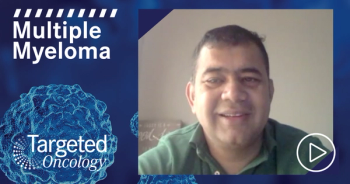
Binod Dhakal, MD, discusses the extended follow-up of combination selinexor in the proteasome inhibitor–naive subgroup of patients with multiple myeloma.

Your AI-Trained Oncology Knowledge Connection!

Binod Dhakal, MD, MS, is associate professor of medicine at the Medical College of Wisconsin, Division of Hematology.

Binod Dhakal, MD, discusses the extended follow-up of combination selinexor in the proteasome inhibitor–naive subgroup of patients with multiple myeloma.

Binod Dhakal, MD, discusses the BOSTON trial of selinexor combination therapy in patients with relapsed/refractory multiple myeloma.

Binod Dhakal, MD, discusses using a variety of combination therapies as bridging or later-line options for patients with relapsed myeloma.
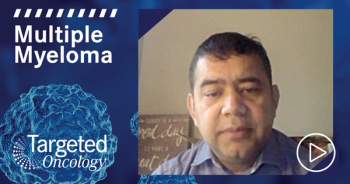
A study shows talquetamab is a safe, effective bridge for high-risk patients, potentially improving outcomes and mitigating CAR T toxicities.

A clinical study reveals talquetamab's effectiveness as a bridging therapy before CAR T-cell treatment for multiple myeloma, enhancing patient outcomes.

Researchers explore talquetamab as a bridge therapy for multiple myeloma patients before CAR T-cell treatment, assessing safety and efficacy outcomes.

Experts explore innovative bridging therapies for multiple myeloma, enhancing patient outcomes before CAR T-cell treatment while addressing significant challenges.

Panelists discuss how chimeric antigen receptor (CAR) T-cell therapy could potentially be moved to earlier lines of treatment in relapsed/refractory multiple myeloma based on emerging trial data, improving outcomes through earlier intervention before patients develop treatment resistance.

Panelists discuss how detailed analyses from KarMMa-3 reveal key insights about ide-cel’s performance across patient subgroups, timing of responses, durability of remissions, and management of adverse effects in relapsed/refractory multiple myeloma (RRMM).

Panelists discuss how the KarMMa-3 trial demonstrated superior efficacy of idecabtagene vicleucel (ide-cel) chimeric antigen receptor T-cell therapy compared to standard treatment regimens in patients with heavily pretreated, triple-class–exposed relapsed/refractory multiple myeloma (RRMM).

Panelists discuss how to select optimal therapy for a 66-year-old patient with early relapse following autologous stem cell transplantation (ASCT), considering factors such as prior treatment exposure, duration of response, and emerging therapeutic options including cellular therapies.

Panelists discuss how to identify, monitor, and manage delayed toxicities following ciltacabtagene autoleucel (cilta-cel) chimeric antigen receptor (CAR) T therapy, including prolonged cytopenias, infections, and neurotoxicity, to optimize long-term patient outcomes and safety.

Panelists discuss how CARTITUDE-4 demonstrated superior progression-free survival and overall response rates with ciltacabtagene autoleucel (cilta-cel) compared with standard treatment options in relapsed/refractory multiple myeloma (R/R MM) patients who received 1 to 3 prior lines of therapy.

Panelists discuss how to address practical challenges in delivering chimeric antigen receptor (CAR) T cell therapy, including patient selection, bridging therapy, manufacturing delays, access barriers, and coordination of care to optimize real-world outcomes.

Panelists discuss how to manage an aggressive case of early posttransplant progression in a young woman with functionally high-risk multiple myeloma (MM), focusing on rapid intervention strategies and novel therapeutic approaches to overcome poor prognosis disease.

Panelists discuss how to approach treatment selection and sequencing for a 58-year-old woman with high-risk multiple myeloma (MM) who has developed progressive disease after stem cell transplantation, considering factors such as prior therapy exposure, available options, and disease biology.

Panelists discuss how to optimize maintenance therapy following autologous stem cell transplantation by evaluating factors such as duration, drug selection, and risk-adapted approaches to maximize long-term outcomes in multiple myeloma patients.

Panelists discuss how the paradigm in transplant-eligible newly diagnosed multiple myeloma (NDMM) has shifted to considering which patients should not receive quadruplet CD38-containing regimens rather than who should, given the compelling efficacy data supporting this approach.

Panelists discuss how the PERSEUS trial demonstrated superior progression-free survival with daratumumab-VRd compared to VRd alone in patients with transplant-eligible newly diagnosed multiple myeloma (NDMM), potentially establishing a new standard of care in this setting.

Panelists discuss how to navigate and choose among multiple guideline-recommended induction regimens for patients with transplant-eligible newly diagnosed multiple myeloma (NDMM) by considering factors such as efficacy data, toxicity profiles, and individual patient characteristics.

Panelists discuss how to optimize treatment selection and sequencing for a 65-year-old patient with standard-risk, transplant-eligible newly diagnosed multiple myeloma (NDMM) through assessment of disease characteristics, patient factors, and available therapeutic options.

Panelists discuss how the IMROZ trial demonstrated improved outcomes with quadruplet therapy combining daratumumab, lenalidomide, melphalan, and prednisone in patients with transplant-ineligible newly diagnosed multiple myeloma (NDMM), highlighting its potential as a new treatment standard.

Panelists discuss how the CEPHEUS trial demonstrates the comparative efficacy and safety of subcutaneous daratumumab combined with VRd vs VRd alone in patients with transplant-ineligible or transplant-deferred newly diagnosed multiple myeloma, highlighting key outcomes and clinical implications.

Panelists discuss how guideline-recommended treatment regimens for patients with transplant-ineligible or transplant-deferred newly diagnosed multiple myeloma should be evaluated and selected based on patient characteristics, efficacy data, and safety profiles to achieve optimal outcomes.

Panelists discuss how to approach treatment decisions for a 74-year-old patient with transplant-ineligible newly diagnosed multiple myeloma patient, considering factors such as age, comorbidities, and available therapeutic options to develop an optimal care plan.
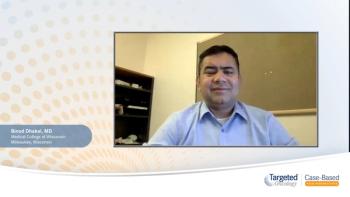
Panelist discusses how there are many significant attributes of the bispecific antibody, which has broader applicability and can be used in widespread community centers. There are more community centers that are staring to use bispecific antibodies, and there is now a much lower rate of CRS and immune effector cell–associated neurotoxicity syndrome (ICANS).

Panelist discusses how pivotal studies led to the approval of teclistamab in patients with less refractory multiple myeloma; the overall response rate was 63% and the progression of survival rate was 11.3 months.

Panelist discusses how, based on the patient achieving sCR with emerging oral, skin, and nail toxicities, panelist would recommend initiating supportive care, including oral hygiene protocols, topical treatments, and prophylactic nail care. These toxicities are generally less severe than those of BCMA-targeted bispecifics, which often present with more systemic CRS and neurotoxicity.

Panelists discuss how recent therapeutic advances, including novel drug combinations and personalized treatment approaches, are reshaping the standard of care for patients with newly diagnosed multiple myeloma (NDMM) while emphasizing the importance of risk stratification and early intervention strategies.

Panelist discusses how talquetamab’s step-up dosing strategy aims to mitigate cytokine release syndrome, a common immunologic toxicity. The reported grade 1 CRS with altered taste and dry mouth represents a mild manifestation compared with the MonumenTAL-1 trial, where the initial SUD schedule showed varying CRS rates. Real-world evidence has largely validated trial findings, though alternative SUD approaches may offer different risk-benefit profiles. The optimal SUD strategy continues to evolve as clinical experience expands, balancing efficacy with tolerability.
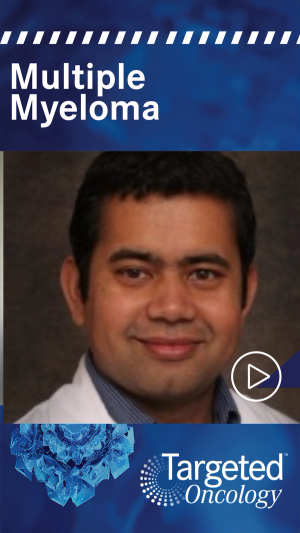
Published: August 20th 2025 | Updated:

Published: August 20th 2025 | Updated:
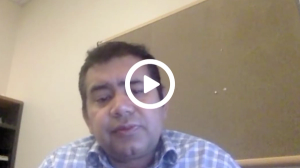
Published: July 2nd 2024 | Updated: